Saturn In Three Bands Of Infrared Light.

Saturn in three bands of infrared light.
More Posts from Littlecadet-biguniverse and Others


Solar surges are cool jets of plasma ejected in the solar atmosphere from chromospheric into coronal heights. This particular surge has been captured in a loopy structure and streamed sunwards along the magnetic field lines.
Surges are associated with active regions and they are most likely triggered by magnetic reconnection and magnetohydrodynamic (MHD) wave activity. According to their morphological features, surge prominences can be classified into three types: jet-like, diffuse, and closed loop (above). Jet-like and diffuse surges are associated with coronal mass ejections (CMEs), but the closed-loop surges are not because the initial acceleration of the eruption is slowed down and finally stopped by the overlying coronal loops.
Credit: SDO/ LMSAL

A Black Hole Choir : The blue dots in this field of galaxies, known as the COSMOS field, show galaxies that contain supermassive black holes emitting high-energy X-rays.
js
Bubble Nebula by Hubble Heritage Via Flickr: For the 26th birthday of NASA’s Hubble Space Telescope, astronomers are highlighting a Hubble image of an enormous bubble being blown into space by a super-hot, massive star. The Hubble image of the Bubble Nebula, or NGC 7635, was chosen to mark the 26th anniversary of the launch of Hubble into Earth orbit by the STS-31 space shuttle crew on April 24, 1990. The Bubble Nebula is 7 light-years across — about one-and-a-half times the distance from our sun to its nearest stellar neighbor, Alpha Centauri. The Bubble Nebula was discovered in 1787 by William Herschel, a prominent British astronomer. It is being formed by a prototypical Wolf-Rayet star, an extremely bright, massive, and short-lived star that has lost most of its outer hydrogen and is now fusing helium into heavier elements. The star is about 4 million years old, and in 10 million to 20 million years, it will likely detonate as a supernova.
Credit: NASA, ESA, and the Hubble Heritage Team (STScI/AURA) heritage.stsci.edu/2016/13/ hubbledev.stsci.edu/newscenter/archive/releases/2016/13/

Cargo transfer bags come in various sizes. I actually fit into this one and as a joke, Thomas and Shane took me over to the Russian segment, zipped inside. They told them there was a present inside and opened it up. I popped out and gave them a good surprise!

Helix Nebula in Visible and in Infrared Light
The Helix Nebula, also known as NGC 7293, is a large planetary nebula (PN) located in the constellation Aquarius. Planetary nebulae like the Helix are sculpted late in a Sun-like star’s life by a torrential gush of gases escaping from the dying star. They have nothing to do with planet formation, but got their name because they look like planetary disks when viewed through a small telescope.
Credit: ESO/VISTA/J. Emerson.


Centaurus A. Same object. Different wavelengths.
It’s scary to think most of our universe is invisible to us

Three LEGO Minifigures Journey to Jupiter
Did you know that the Juno mission is also one giant leap for minifigure-kind? Three LEGO crew members have set their sights on being the first toy to visit another planet, enduring the five year, 1.75 billion mile journey aboard NASA’s Juno spacecraft. One minifigure is a likeness of Galileo Galilei – who discovered Jupiter’s four largest moons. The other two represent the Roman god Jupiter and his wife Juno. Each figure has been custom molded out of aluminum to represent their special characteristics. Jupiter carries a lightning bolt, Juno has a magnifying glass to represent her search for truth, Galileo is carrying a telescope and a model of the planet Jupiter.
To me, these minifigures add a beautifully ordinary and intensely human element to this extraordinary mission.
Explore more of the LEGO Group’s partnership with NASA at LEGO.com/Space

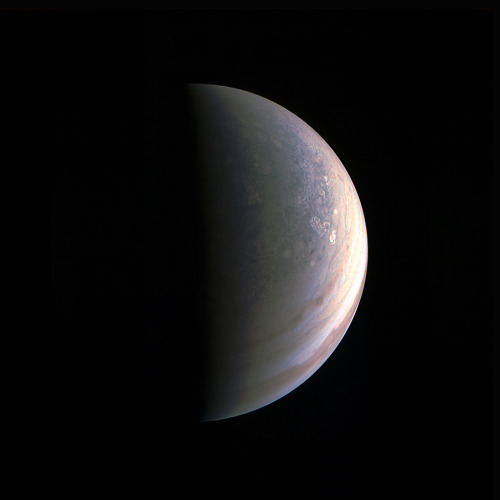
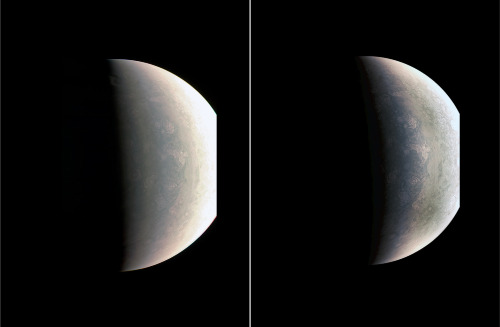
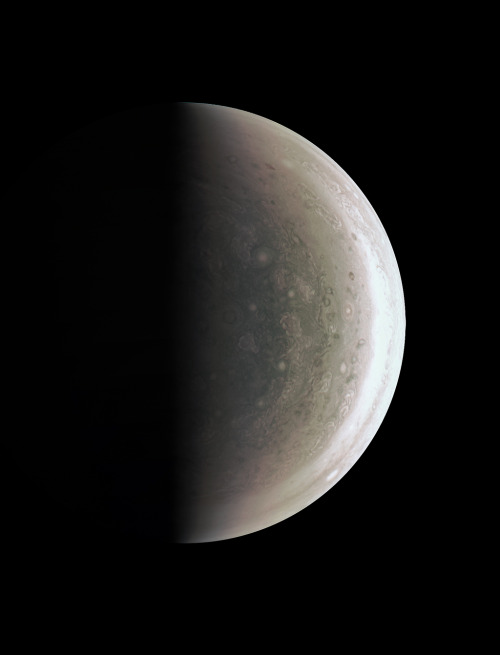
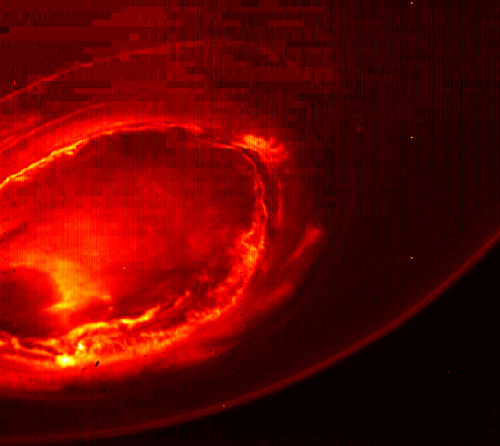
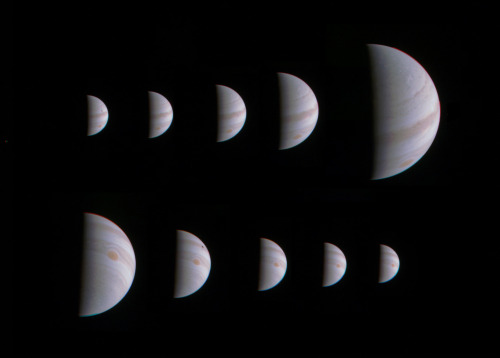
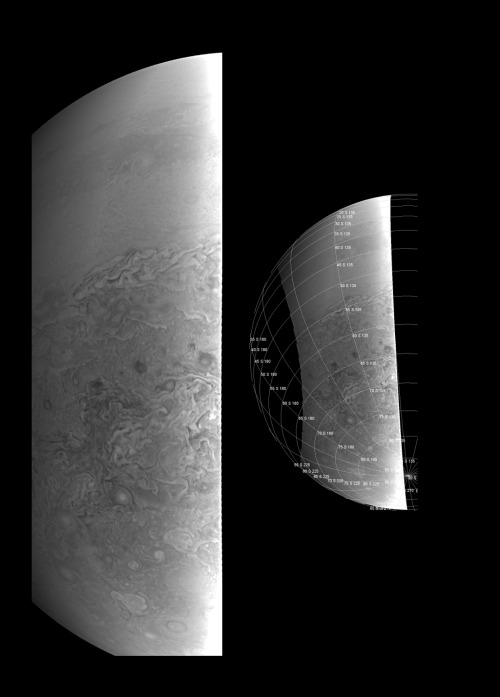
Jupiter’s North Pole Unlike Anything Encountered in Solar System
NASA’s Juno spacecraft has sent back the first-ever images of Jupiter’s north pole, taken during the spacecraft’s first flyby of the planet with its instruments switched on. The images show storm systems and weather activity unlike anything previously seen on any of our solar system’s gas-giant planets.
Juno successfully executed the first of 36 orbital flybys on Aug. 27 when the spacecraft came about 2,500 miles (4,200 kilometers) above Jupiter’s swirling clouds. The download of six megabytes of data collected during the six-hour transit, from above Jupiter’s north pole to below its south pole, took one-and-a-half days. While analysis of this first data collection is ongoing, some unique discoveries have already made themselves visible.
“First glimpse of Jupiter’s north pole, and it looks like nothing we have seen or imagined before,” said Scott Bolton, principal investigator of Juno from the Southwest Research Institute in San Antonio. “It’s bluer in color up there than other parts of the planet, and there are a lot of storms. There is no sign of the latitudinal bands or zone and belts that we are used to – this image is hardly recognizable as Jupiter. We’re seeing signs that the clouds have shadows, possibly indicating that the clouds are at a higher altitude than other features.”
One of the most notable findings of these first-ever pictures of Jupiter’s north and south poles is something that the JunoCam imager did not see.
“Saturn has a hexagon at the north pole,” said Bolton. “There is nothing on Jupiter that anywhere near resembles that. The largest planet in our solar system is truly unique. We have 36 more flybys to study just how unique it really is.”
Along with JunoCam snapping pictures during the flyby, all eight of Juno’s science instruments were energized and collecting data. The Jovian Infrared Auroral Mapper (JI-RAM), supplied by the Italian Space Agency, acquired some remarkable images of Jupiter at its north and south polar regions in infrared wavelengths.
“JIRAM is getting under Jupiter’s skin, giving us our first infrared close-ups of the planet,” said Alberto Adriani, JIRAM co-investigator from Istituto di Astrofisica e Planetologia Spaziali, Rome. “These first infrared views of Jupiter’s north and south poles are revealing warm and hot spots that have never been seen before. And while we knew that the first ever infrared views of Jupiter’s south pole could reveal the planet’s southern aurora, we were amazed to see it for the first time. No other instruments, both from Earth or space, have been able to see the southern aurora. Now, with JIRAM, we see that it appears to be very bright and well structured. The high level of detail in the images will tell us more about the aurora’s morphology and dynamics.”
Among the more unique data sets collected by Juno during its first scientific sweep by Jupiter was that acquired by the mission’s Radio/Plasma Wave Experiment (Waves), which recorded ghostly- sounding transmissions emanating from above the planet. These radio emissions from Jupiter have been known about since the 1950s but had never been analyzed from such a close vantage point.
“Jupiter is talking to us in a way only gas-giant worlds can,” said Bill Kurth, co-investigator for the Waves instrument from the University of Iowa, Iowa City. “Waves detected the signature emissions of the energetic particles that generate the massive auroras which encircle Jupiter’s north pole. These emissions are the strongest in the solar system. Now we are going to try to figure out where the electrons come from that are generating them.”
The Juno spacecraft launched on Aug. 5, 2011, from Cape Canaveral, Florida and arrived at Jupiter on July 4, 2016. JPL manages the Juno mission for the principal investigator, Scott Bolton, of Southwest Research Institute in San Antonio. Juno is part of NASA’s New Frontiers Program, which is managed at NASA’s Marshall Space Flight Center in Huntsville, Alabama, for NASA’s Science Mission Directorate. Lockheed Martin Space Systems, Denver, built the spacecraft. Caltech in Pasadena, California, manages JPL for NASA.
IMAGE 1….As NASA’s Juno spacecraft closed in on Jupiter for its Aug. 27, 2016 pass, its view grew sharper and fine details in the north polar region became increasingly visible. The JunoCam instrument obtained this view on August 27, about two hours before closest approach, when the spacecraft was 120,000 miles (195,000 kilometers) away from the giant planet (i.e., for Jupiter’s center). Unlike the equatorial region’s familiar structure of belts and zones, the poles are mottled with rotating storms of various sizes, similar to giant versions of terrestrial hurricanes. Jupiter’s poles have not been seen from this perspective since the Pioneer 11 spacecraft flew by the planet in 1974.
IMAGE 2….Storm systems and weather activity unlike anything encountered in the solar system are on view in these color images of Jupiter’s north polar region from NASA’s Juno spacecraft. Two versions of the image have been contrast-enhanced differently to bring out detail near the dark terminator and near the bright limb. The JunoCam instrument took the images to create this color view on August 27, when the spacecraft was about 48,000 miles (78,000 kilometers) above the polar cloud tops. A wavy boundary is visible halfway between the grayish region at left (closer to the pole and the nightside shadow) and the lighter-colored area on the right. The wavy appearance of the boundary represents a Rossby wave – a north-south meandering of a predominantly east-west flow in an atmospheric jet. This may be caused by a difference in temperature between air to the north and south of this boundary, as is often the case with such waves in Earth’s atmosphere. The polar region is filled with a variety of discrete atmospheric features. Some of these are ovals, but the larger and brighter features have a “pinwheel” shape reminiscent of the shape of terrestrial hurricanes. Tracking the motion and evolution of these features across multiple orbits will provide clues about the dynamics of the Jovian atmosphere. This image also provides the first example of cloud shadowing on Jupiter: near the top of the image, a high cloud feature is seen past the normal boundary between day and night, illuminated above the cloud deck below. While subtle color differences are visible in the image, some of these are likely the result of scattered light within the JunoCam optics. Work is ongoing to characterize these effects.
IMAGE 3….This image from NASA’s Juno spacecraft provides a never-before-seen perspective on Jupiter’s south pole. The JunoCam instrument acquired the view on August 27, 2016, when the spacecraft was about 58,700 miles (94,500 kilometers) above the polar region. At this point, the spacecraft was about an hour past its closest approach, and fine detail in the south polar region is clearly resolved. Unlike the equatorial region’s familiar structure of belts and zones, the poles are mottled by clockwise and counterclockwise rotating storms of various sizes, similar to giant versions of terrestrial hurricanes. The south pole has never been seen from this viewpoint, although the Cassini spacecraft was able to observe most of the polar region at highly oblique angles as it flew past Jupiter on its way to Saturn in 2000
IMAGE 4….This infrared image gives an unprecedented view of the southern aurora of Jupiter, as captured by NASA’s Juno spacecraft on August 27, 2016. The planet’s southern aurora can hardly be seen from Earth due to our home planet’s position in respect to Jupiter’s south pole. Juno’s unique polar orbit provides the first opportunity to observe this region of the gas-giant planet in detail. Juno’s Jovian Infrared Auroral Mapper (JIRAM) camera acquired the view at wavelengths ranging from 3.3 to 3.6 microns – the wavelengths of light emitted by excited hydrogen ions in the polar regions. The view is a mosaic of three images taken just minutes apart from each other, about four hours after the perijove pass while the spacecraft was moving away from Jupiter.
IMAGE 5….This montage of 10 JunoCam images shows Jupiter growing and shrinking in apparent size before and after NASA’s Juno spacecraft made its closest approach on August 27, 2016, at 12:50 UTC. The images are spaced about 10 hours apart, one Jupiter day, so the Great Red Spot is always in roughly the same place. The small black spots visible on the planet in some of the images are shadows of the large Galilean moons. The images in the top row were taken during the inbound leg of the orbit, beginning on August 25 at 13:15 UTC when Juno was 1.4 million miles (2.3 million kilometers) away from Jupiter, and continuing to August 27 at 04:45 UTC when the spacecraft was 430,000 miles (700,000 kilometers) away. The images in the bottom row were obtained during the outbound leg of the orbit. They begin on August 28 at 00:45 UTC when Juno was 750,000 miles (920,000 kilometers) away and continue to August 29 at 16:45 UTC when the spacecraft was 1.6 million miles (2.5 million kilometers) away.
IMAGE 6….This image provides a close-up view of Jupiter’s southern hemisphere, as seen by NASA’s Juno spacecraft on August 27, 2016. The JunoCam instrument captured this image with its red spectral filter when the spacecraft was about 23,600 miles (38,000 kilometers) above the cloud tops. The image covers an area from close to the south pole to 20 degrees south of the equator, centered on a longitude at about 140 degrees west. The transition between the banded structures near the equator and the more chaotic polar region (south of about 65 degrees south latitude) can be clearly seen. The smaller version at right of this image shows the same view with a latitude/longitude grid overlaid. This image has been processed to remove shading effects near the terminator – the dividing line between day and night – caused by Juno’s orbit.
-
 high-witchery liked this · 5 years ago
high-witchery liked this · 5 years ago -
 nycewell liked this · 7 years ago
nycewell liked this · 7 years ago -
 balvorn liked this · 8 years ago
balvorn liked this · 8 years ago -
 5-headed-goat-wizard reblogged this · 8 years ago
5-headed-goat-wizard reblogged this · 8 years ago -
 interplanetaryfox reblogged this · 8 years ago
interplanetaryfox reblogged this · 8 years ago -
 visual-soundwaves-blog1 reblogged this · 8 years ago
visual-soundwaves-blog1 reblogged this · 8 years ago -
 hippiewiththesadeyes-blog reblogged this · 8 years ago
hippiewiththesadeyes-blog reblogged this · 8 years ago -
 drearyciel liked this · 8 years ago
drearyciel liked this · 8 years ago -
 uninter3sting liked this · 8 years ago
uninter3sting liked this · 8 years ago -
 automata-systemata-hydromata reblogged this · 8 years ago
automata-systemata-hydromata reblogged this · 8 years ago -
 automata-systemata-hydromata liked this · 8 years ago
automata-systemata-hydromata liked this · 8 years ago -
 silentstar reblogged this · 8 years ago
silentstar reblogged this · 8 years ago -
 starrgloww liked this · 8 years ago
starrgloww liked this · 8 years ago -
 yucky-wucky liked this · 8 years ago
yucky-wucky liked this · 8 years ago -
 queernundrum reblogged this · 8 years ago
queernundrum reblogged this · 8 years ago -
 vitalblemish reblogged this · 8 years ago
vitalblemish reblogged this · 8 years ago -
 b-eg reblogged this · 8 years ago
b-eg reblogged this · 8 years ago -
 outerspacecandy reblogged this · 8 years ago
outerspacecandy reblogged this · 8 years ago -
 kryopods reblogged this · 8 years ago
kryopods reblogged this · 8 years ago -
 stxrr419 reblogged this · 8 years ago
stxrr419 reblogged this · 8 years ago -
 n1ghtwo1f liked this · 8 years ago
n1ghtwo1f liked this · 8 years ago -
 gaylienz liked this · 8 years ago
gaylienz liked this · 8 years ago -
 interplanetaryfox reblogged this · 8 years ago
interplanetaryfox reblogged this · 8 years ago -
 dan958 liked this · 8 years ago
dan958 liked this · 8 years ago -
 inspiredlunacy404 reblogged this · 8 years ago
inspiredlunacy404 reblogged this · 8 years ago -
 palkias-space reblogged this · 8 years ago
palkias-space reblogged this · 8 years ago -
 cucumbercum liked this · 8 years ago
cucumbercum liked this · 8 years ago -
 latinsheets reblogged this · 8 years ago
latinsheets reblogged this · 8 years ago -
 latinsheets liked this · 8 years ago
latinsheets liked this · 8 years ago -
 blacklilly888 reblogged this · 8 years ago
blacklilly888 reblogged this · 8 years ago -
 blacklilly888 liked this · 8 years ago
blacklilly888 liked this · 8 years ago -
 shymoon002 liked this · 8 years ago
shymoon002 liked this · 8 years ago -
 tiranosauriosrex liked this · 8 years ago
tiranosauriosrex liked this · 8 years ago -
 loathesome-is-love-blog reblogged this · 8 years ago
loathesome-is-love-blog reblogged this · 8 years ago -
 loathesome-is-love-blog liked this · 8 years ago
loathesome-is-love-blog liked this · 8 years ago -
 littlecadet-biguniverse reblogged this · 8 years ago
littlecadet-biguniverse reblogged this · 8 years ago -
 ostentatiousrrex liked this · 8 years ago
ostentatiousrrex liked this · 8 years ago -
 chusilla-blog1 reblogged this · 8 years ago
chusilla-blog1 reblogged this · 8 years ago -
 lawmluna liked this · 8 years ago
lawmluna liked this · 8 years ago -
 xalabaar liked this · 8 years ago
xalabaar liked this · 8 years ago -
 cosmicmeatball-blog reblogged this · 8 years ago
cosmicmeatball-blog reblogged this · 8 years ago -
 dim-time liked this · 8 years ago
dim-time liked this · 8 years ago
GREETINGS FROM EARTH! Welcome to my space blog! Let's explore the stars together!!!
144 posts